1. Innis SM. Fatty acids and early human development. Early Hum Dev. 2007; 83:761–766. PMID:
17920214.
2. The Korean Nutrition Society. Dietary Reference Intakes for Koreans 2015. Seoul: Ministry of Health and Welfare, the Korean Nutrition Society;2016.
3. Corvalán C, Uauy R, Kain J, Martorell R. Obesity indicators and cardiometabolic status in 4-y-old children. Am J Clin Nutr. 2010; 91:166–174. PMID:
19923378.
4. Hooper L, Abdelhamid A, Moore HJ, Douthwaite W, Skeaff CM, Summerbell CD. Effect of reducing total fat intake on body weight: systematic review and meta-analysis of randomised controlled trials and cohort studies. BMJ. 2012; 345:e7666. PMID:
23220130.
5. Kosti RI, Panagiotakos DB. The epidemic of obesity in children and adolescents in the world. Cent Eur J Public Health. 2006; 14:151–159. PMID:
17243492.
6. Geserick M, Vogel M, Gausche R, Lipek T, Spielau U, Keller E, Pfäffle R, Kiess W, Körner A. Acceleration of BMI in early childhood and risk of sustained obesity. N Engl J Med. 2018; 379:1303–1312. PMID:
30281992.
7. Ward ZJ, Long MW, Resch SC, Giles CM, Cradock AL, Gortmaker SL. Simulation of growth trajectories of childhood obesity into adulthood. N Engl J Med. 2017; 377:2145–2153. PMID:
29171811.
8. Mensink RP. Effects of Saturated Fatty Acids on Serum Lipids and Lipoproteins: a Systematic Review and Regression Analysis. Geneva: World Health Organization;2016.
9. Wong ND. Epidemiological studies of CHD and the evolution of preventive cardiology. Nat Rev Cardiol. 2014; 11:276–289. PMID:
24663092.
10. Berenson GS, Srinivasan SR, Nicklas TA. Atherosclerosis: a nutritional disease of childhood. Am J Cardiol. 1998; 82:22T–29T. PMID:
9671003.
11. Nicklas TA, Dwyer J, Feldman HA, Luepker RV, Kelder SH, Nader PR. Serum cholesterol levels in children are associated with dietary fat and fatty acid intake. J Am Diet Assoc. 2002; 102:511–517. PMID:
11985407.
12. Cui Z, Dibley MJ. Trends in dietary energy, fat, carbohydrate and protein intake in Chinese children and adolescents from 1991 to 2009. Br J Nutr. 2012; 108:1292–1299. PMID:
22244308.
13. Ervin RB, Ogden CL. Trends in Intake of Energy and Macronutrients in Children and Adolescents from 1999–2000 through 2009–2010. NCHS Data Brief, No 113. Hyattsville: National Center for Health Statistics;2013.
14. Libuda L, Alexy U, Kersting M. Time trends in dietary fat intake in a sample of German children and adolescents between 2000 and 2010: not quantity, but quality is the issue. Br J Nutr. 2014; 111:141–150. PMID:
23830595.
15. Pot GK, Prynne CJ, Roberts C, Olson A, Nicholson SK, Whitton C, Teucher B, Bates B, Henderson H, Pigott S, et al. National diet and nutrition survey: fat and fatty acid intake from the first year of the rolling programme and comparison with previous surveys. Br J Nutr. 2012; 107:405–415. PMID:
21767448.
16. Neufingerl N, Djuwita R, Otten-Hofman A, Nurdiani R, Garczarek U, Sulaeman A, Zock PL, Eilander A. Intake of essential fatty acids in Indonesian children: secondary analysis of data from a nationally representative survey. Br J Nutr. 2016; 115:687–693. PMID:
26824732.
17. Satheannoppakao W, Kasemsup R, Nontarak J, Kessomboon P, Putwatana P, Taneepanichskul S, Sangthong R, Chariyalertsak S, Aekplakorn W. Energy and macronutrient intakes and food sources in preschool children: Thai NHES IV. J Med Assoc Thai. 2015; 98:957–967. PMID:
26638587.
18. Korea Centers for Disease Control and Prevention. Korea Health Statistics 2017: Korea National Health and Nutrition Examination Survey (KNHANES VII-2). Cheongju: Korea Centers for Disease Control and Prevention;2018.
19. U.S. Department of Agriculture, Agricultural Research Service. Energy Intakes: Percentages of Energy from Protein, Carbohydrate, Fat, and Alcohol, by Gender and Age, What We Eat in America, NHANES 2015–2016. Beltsville (MD): U.S. Department of Agriculture, Agricultural Research Service;2018.
20. Harika RK, Cosgrove MC, Osendarp SJ, Verhoef P, Zock PL. Fatty acid intakes of children and adolescents are not in line with the dietary intake recommendations for future cardiovascular health: a systematic review of dietary intake data from thirty countries. Br J Nutr. 2011; 106:307–316. PMID:
21554818.
21. Rippin HL, Hutchinson J, Jewell J, Breda JJ, Cade JE. Child and adolescent nutrient intakes from current national dietary surveys of European populations. Nutr Res Rev. 2019; 32:38–69. PMID:
30388967.
22. Kwon E, Nah EH. Secular trends in height, weight and obesity among Korean children and adolescents in 2006–2015. Korean J Health Educ Promot. 2016; 33:1–13.
23. Yoon MO, Kim K, Hwang JY, Lee HS, Son TY, Moon HK, Shim JE. Development of a fatty acids database using the Korea National Health and Nutrition Examination Survey data. J Nutr Health. 2014; 47:435–442.
24. Kweon S, Kim Y, Jang MJ, Kim Y, Kim K, Choi S, Chun C, Khang YH, Oh K. Data resource profile: the Korea National Health and Nutrition Examination Survey (KNHANES). Int J Epidemiol. 2014; 43:69–77. PMID:
24585853.
25. Korean Rural Development Administration, National Institute of Agricultural Sciences. Food Composition Table. 7th ed. Suwon: National Institute of Agricultural Sciences;2006.
26. Korean Rural Development Administration, National Institute of Agricultural Sciences. Food Composition Table. 8th ed. Suwon: National Institute of Agricultural Sciences;2011.
27. Korean Rural Development Administration, National Institute of Agricultural Sciences. Food Composition Table. 9th ed. Wanju: National Institute of Agricultural Sciences;2016.
28. Song S, Shim JE. Trends in dietary intake of total fat and fatty acids among Korean adolescents from 2007 to 2017. Nutrients. 2019; 11:3073.
29. Song S, Shim JE, Song WO. Trends in total fat and fatty acid intakes and chronic health conditions in Korean adults over 2007–2015. Public Health Nutr. 2019; 22:1341–1350. PMID:
30767815.
30. Song S, Shim JE. Evaluation of total fat and fatty acids intakes in the Korean adult population using data from the 2016–2017 Korea National Health and Nutrition Examination Surveys. Korean J Community Nutr. 2019; 24:223–231.
31. Keim SA, Branum AM. Dietary intake of polyunsaturated fatty acids and fish among US children 12–60 months of age. Matern Child Nutr. 2015; 11:987–998. PMID:
24034437.
32. Lien VW, Clandinin MT. Dietary assessment of arachidonic acid and docosahexaenoic acid intake in 4–7 year-old children. J Am Coll Nutr. 2009; 28:7–15. PMID:
19571154.
33. Madden SM, Garrioch CF, Holub BJ. Direct diet quantification indicates low intakes of (n-3) fatty acids in children 4 to 8 years old. J Nutr. 2009; 139:528–532. PMID:
19158221.
34. Meyer BJ, Mann NJ, Lewis JL, Milligan GC, Sinclair AJ, Howe PR. Dietary intakes and food sources of omega-6 and omega-3 polyunsaturated fatty acids. Lipids. 2003; 38:391–398. PMID:
12848284.
35. Barbarich BN, Willows ND, Wang L, Clandinin MT. Polyunsaturated fatty acids and anthropometric indices of children in rural China. Eur J Clin Nutr. 2006; 60:1100–1107. PMID:
16538238.
36. Baek Y, Shim JE, Song S. Dietary intake of fat and fatty acids by 1–5-year-old children in Korea: a cross-sectional study based on data from the sixth Korea National Health and Nutrition Examination Survey. Nutr Res Pract. 2018; 12:324–335. PMID:
30090170.
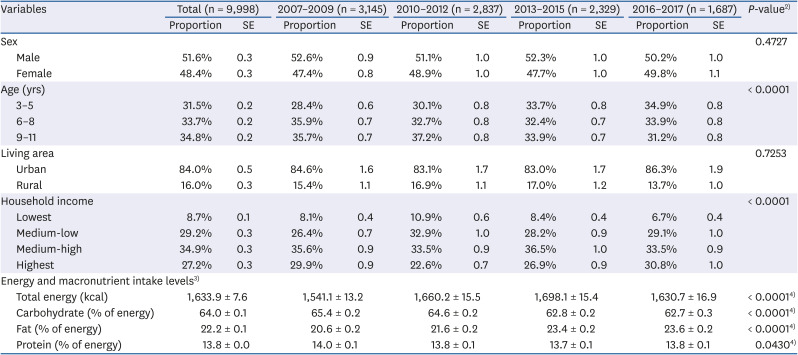
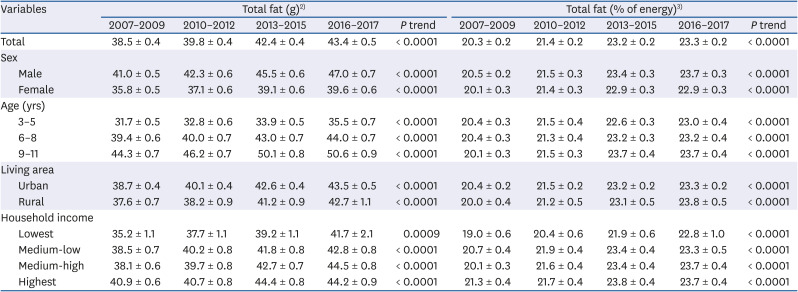
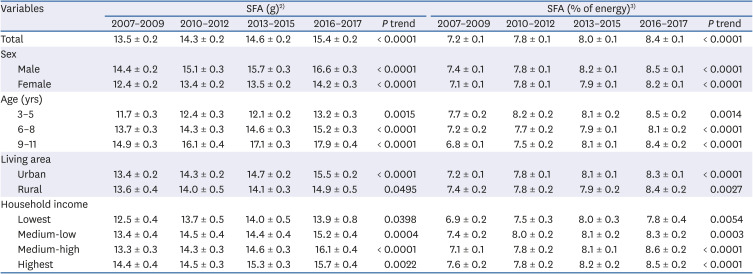
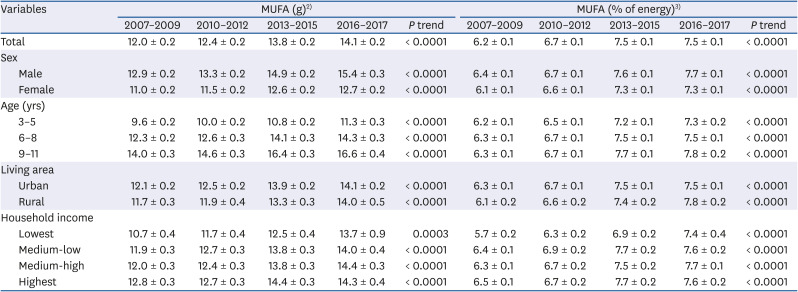
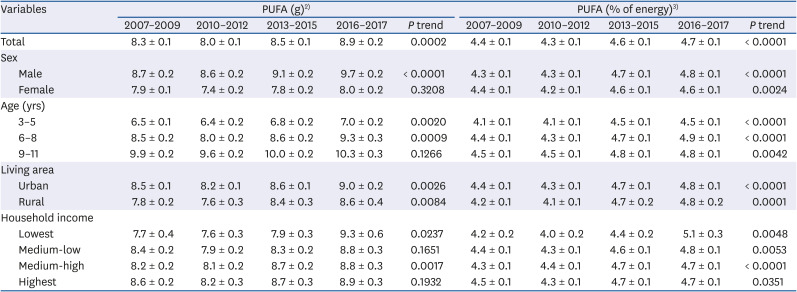
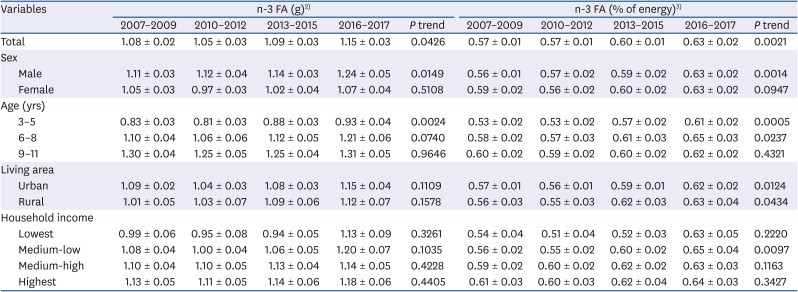
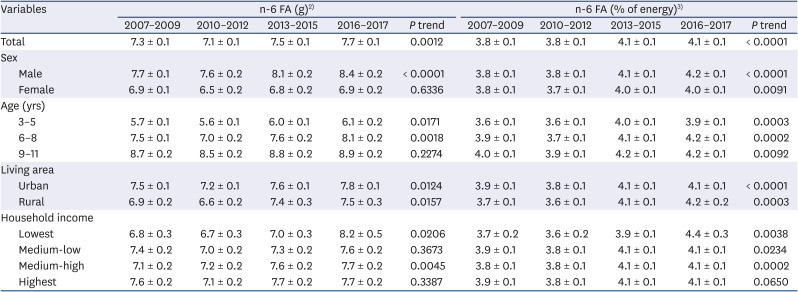
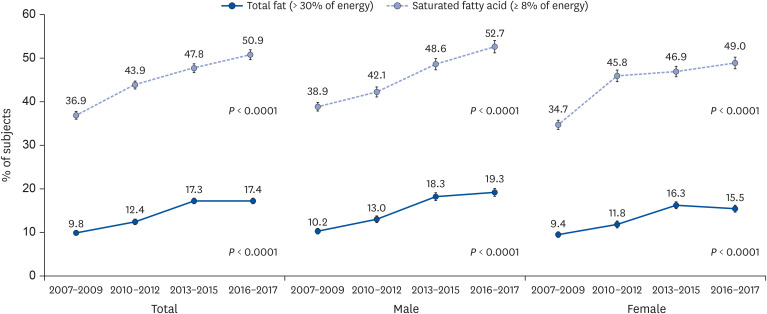




 PDF
PDF Citation
Citation Print
Print



 XML Download
XML Download